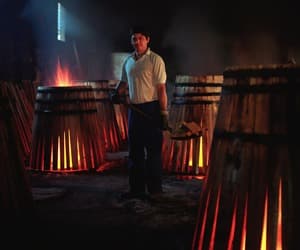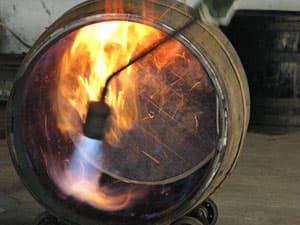BARRELS AND AGEING

Appreciated for their solidity and water tightness, oak barrels have long been used as containers, whatever their country of origin. From the 20th century, being obliged to age their whisky for a minimum of three years, manufacturers began taking an interest in the properties of oak and its impact on a whisky’s aromas and colour.
OAK TYPES AND PROPERTIES
There are over fifty different varieties of oak around the world, but only a handful contain the properties required to age whisky. The most frequently used variety is quercus alba (white oak), which grows in the north-eastern forests of the United States. Easy to mould, with a hard, tight grain, this wood is renowned for its low porosity. White oak is especially used for ageing American whiskeys as well as fino sherry and Amontillado.
European oak varieties such as quercus robur, quercus sessilis or petrae, are notably used in ageing oloroso sherry, the barrels of which are highly sought-after by Scottish distilleries. This oak features a much softer grain that allows more aromatic compounds to be extracted. As different finishing practices have been developed, other varieties of oak have been introduced, notably French Limousin oak (quercus pedunculata), which is used to age cognac. The age of the oak timber used can vary from forty to a hundred years for American oak and sixty to one hundred and fifty for European oak..
THE DIFFERENT TYPES OF BARRELS

Whiskies undergo a slow ageing process in oak barrels of varying capacities. Smaller barrels encourage faster development of aromas due to the higher proportion of wood in the alcohol/wood ratio. There are four main types of barrel used :
BOURBON BARRELS, 180 LITERS
Used to age American whiskeys, this barrel was introduced to Scotland in the 1930s and now supplies close to 97% of demand. Bourbon barrels are taken apart and sent to Scotland as staves. Once they have been reassembled, they undergo a charring process to a greater or lesser extent.
HOGSHEAD BARRELS, 250 LITERS
This barrel is made of former bourbon barrel staves combined with some new or used staves.
SHERRY BUTTS, 480-520 LITERS
The first sherry barrels came from Jerez de la Frontera bodegas (bota de Jerez) in Andalusia. These barrels are the most expensive on the market and are increasingly hard to find.
PUNCHEON BARRELS, 480-520 LITERS
Made from American white oak, these barrels were introduced in the 1960s. Mostly used for ageing grain whiskies, they are gradually disappearing.
All of these barrels can be used in their original state, or can be subjected to various processes, such as wine seasoning (where the barrel is lent to bodegas to age their sherry before being returned to the distilleries and used for ageing whisky) or charring (the inside of the barrel is burnt more or less intensively to concentrate and bring the aromatic compounds of the oak to the surface). The lifespan of a barrel is estimated at around sixty years.
The current trend is for special barrel finishing techniques. A growing number of Scottish distilleries are experimenting with barrels having contained madeira, port, Sauternes, Bordeaux wines, calvados, etc. All of these various barrels contribute to broadening and diversifying the aromatic palette and taste of whiskies.
AGEING CONDITIONS
THE WAREHOUSES
<
Over the last 30 years, traditional earthen dunnage warehouses built close to the distilleries have gradually been replaced by rack warehouses dotted around different sites in Scotland. In dunnage warehouses, the barrels are stored directly on the floor on top of each other in three layers. These warehouses encouraged harmonious ageing because of high humidity levels and better air circulation. Rack warehouses enable the barrels to be stored in metallic racks to a height and depth of several metres. This type of storage helps maintain air temperature and reduces alcohol evaporation. The latter is a an inevitable phenomenon within the barrel-ageing process and is poetically known as the angel's share.
CLIMATE
Whisky evaporates at an estimated rate of 2% per year depending on the climate. The lower the temperature, the more humid the warehouse and the more likely the alcohol is to evaporate (being more volatile than water). Thus, the whisky loses its alcoholic strength but not its volume. Conversely, the higher the temperature, the drier the warehouse and the more likely the water is to evaporate. In these conditions, the volume of the whisky drops but the alcoholic strength remains stable. In reality, every barrel seems to react differently, and within a single warehouse, two barrels of whisky from the same distillate rarely contain a similar alcohol content (there can even be a difference of ten percent). Temperature variations and the position of the barrel inside the warehouse are responsible for these discrepancies.
ENVIRONMENT
The surrounding air that seeps through the wood’s pores also plays a role. Whiskies that are aged close to the sea, notably those from the Campbeltown peninsula, the Isle of Islay and the Isle of Skye, are infused with maritime aromas, often with very pronounced salty flavours.
AGEING FLAVOURS
A whisky’s bouquet is the result of complex chemical reactions that occur between the distillate and the wood’s various compounds. The latter include tannins, lignin, lactones, glycerin, polysaccharides (sugar), fatty acids and aromatic aldehydes. By breaking down the lignin, the alcohol releases aldehydes, the most well-known of which, vanillin, appears from the very beginning of the ageing process. Fruity and floral esters emerge over more time. They are most noticeable in whiskies aged from ten to fifteen years. Younger whiskies display aromas closer to those of grains, and reveal a subtle fruitiness (pears). Whiskies aged over twenty-five years reveal refined exotic aromas (coconut milk) whatever their origin, due to the lactones (present in high concentration in oak) that take some time to infuse the whisky.
At the end of the ageing process, the whisky also changes texture: by releasing solid particles (sugars and glycerin), it becomes smoother. Over the course of the first few years of ageing, the whisky takes on a beautiful golden or amber shade. This phenomenon is heightened in cases where the whisky is aged in first-fill barrels that have only contained a single bourbon or sherry. The latter boast hues that vary from golden yellow to coppery red, depending on whether they have been aged in fino or oloroso sherry barrels. Conversely, bourbon barrels used multiple times will have practically zero influence on the colour of the whisky - these barrels only serve as a finishing agent. The ageing process is never a passive one. Responsible for 40% to 80% of a whisky’s aromatic palette, oak barrels act literally as a melting pot in which all of the elements that contribute to bringing a whisky to life meld and fuse.